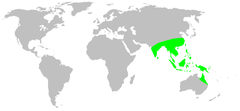|
Psechridae
Psechridae is a family of araneomorph spiders with about 70 species in two genera.[1][2] These are among the biggest cribellate spiders with body lengths up to 2 centimetres (0.79 in) and funnel webs more than 1 metre (3 ft 3 in) in diameter.[3] The family belongs to the RTA clade of spiders because they all have a Retrolateral Tibial Apophysis on the male pedipalp. A recent phylogenetic analysis places Psechridae as close relatives of the lynx spiders, wolf spiders, and nursery web spiders.[4] They feature several characteristics normally found in ecribellate spiders, for example brood care behavior, and a colulus with no apparent function.[5] They have greatly elongated legs, with the last element being very flexible. Female Psechrus carry their egg-sac in the chelicerae, similar to their relatives, the ecribellate Pisauridae. Members of Psechrus construct horizontal webs lace webs, while Fecenia construct pseudo-orbs, similar to orb webs of Orbiculariae spiders in an example of evolutionary convergence.[4][6] DistributionThey occur in southeastern Asia, ranging from India in the west, to Solomon Islands in the east, reaching as far south as northern Australia, and north to central China.[7] They are found in forest, rocky areas, and caves from lowlands to altitudes exceeding 2,000 metres (1.2 mi). GeneraAs of April 2019[update], the World Spider Catalog accepts the following genera:[7]
See alsoReferences
Further reading
Wikispecies has information related to Psechridae. |
||||||||||||||||||||||||||||||||||

